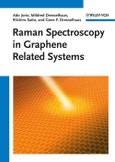Raman spectroscopy is the inelastic scattering of light by matter. Being highly sensitive to the physical and chemical properties of materials, as well as to environmental effects that change these properties, Raman spectroscopy is now evolving into one of the most important tools for nanoscience and nanotechnology. In contrast to usual microscopyrelated techniques, the advantages of using light for nanoscience relate to both experimental and fundamental aspects.
Table of Contents
Part I Materials Science and Raman Spectroscopy BackgroundThe sp? Nanocarbons: Prototypes for Nanoscience and Nanotechnology
Electrons in sp? Nanocarbons
Vibrations in sp? Nanocarbons
Raman Spectroscopy: From Graphite to sp? Nanocarbons
Quantum Description of Raman Scattering
Symmetry Aspects and Selection Rules: Group Theory
Part II Detailed Analysis of Raman Spectroscopy in Graphene Releated Systems
The G-band and time-Independent Perturbations
The G-band and the Time-Dependent Perturbations
Resonance Raman Scattering: Experimental Observations of the Radial Breathing Mode
Theory of Excitons in Carbon Nanotubes
Tight-Binding Method for Calculating Raman Spectra
Dispersive G'-band and Higher-Order Processes:the Double Resonance Process
Disorder Effects in the Raman Spectra of sp? Carbons
Summary of Raman on sp? Nanocarbons








